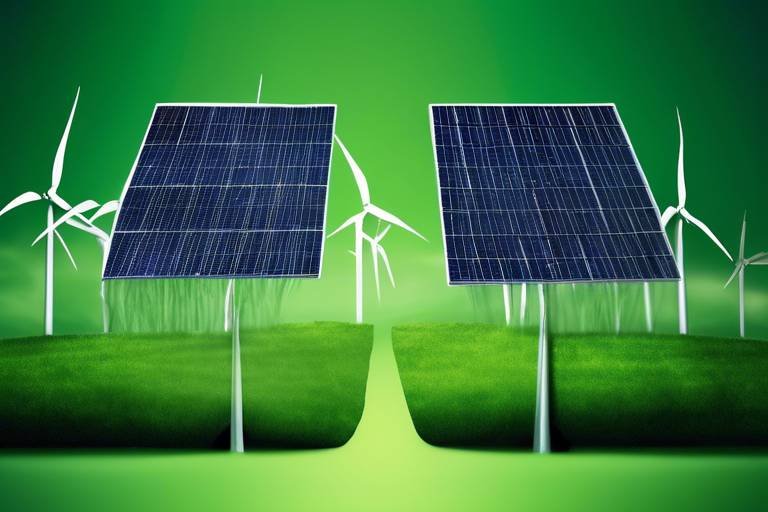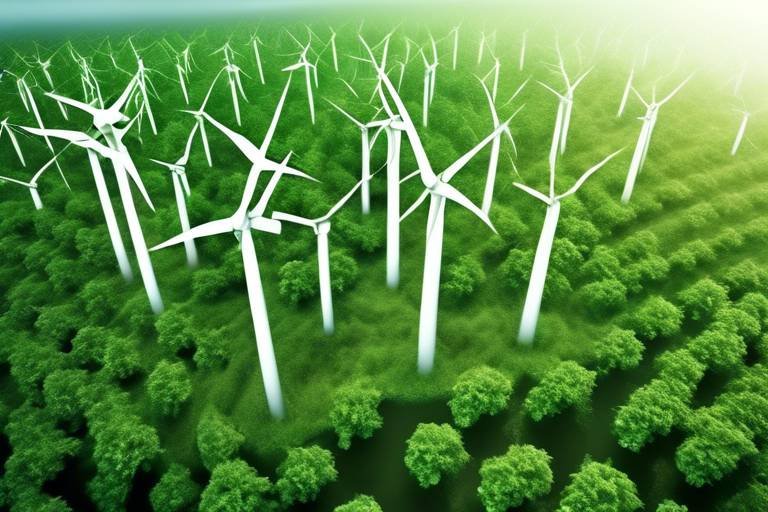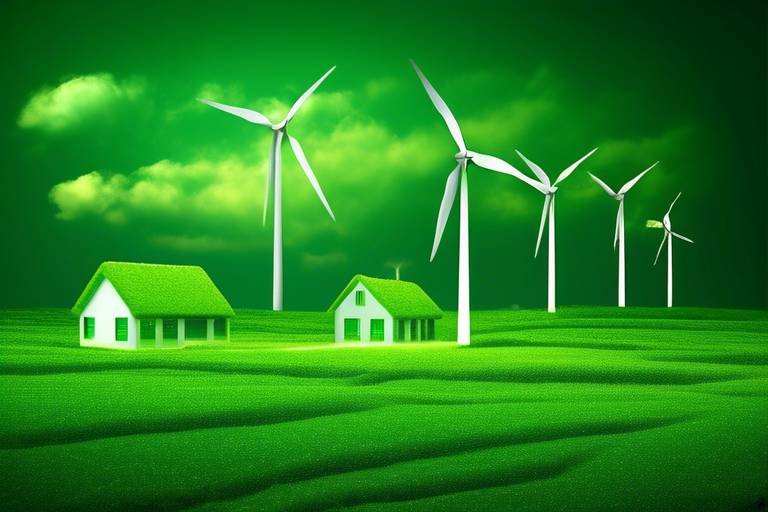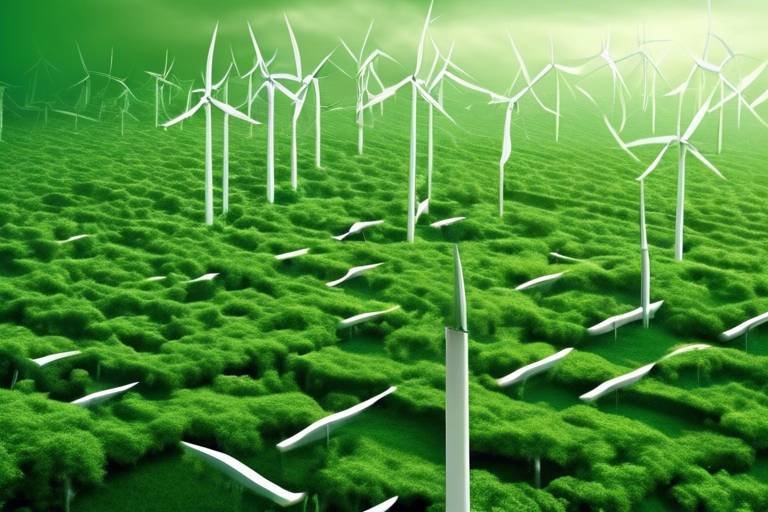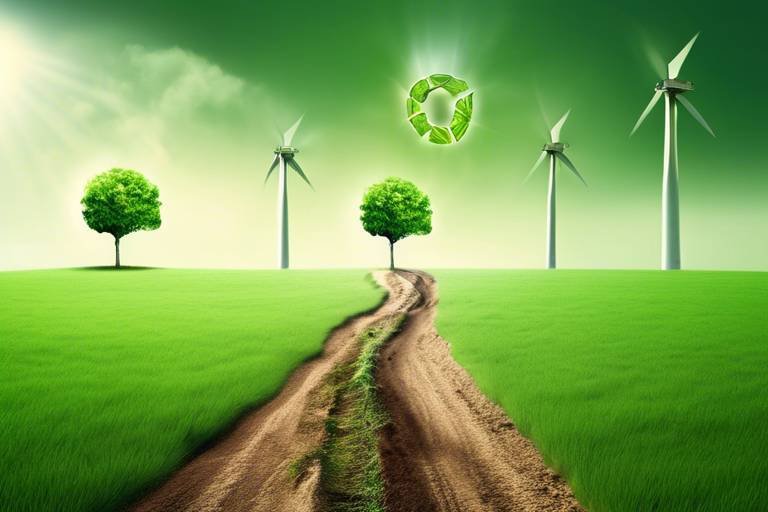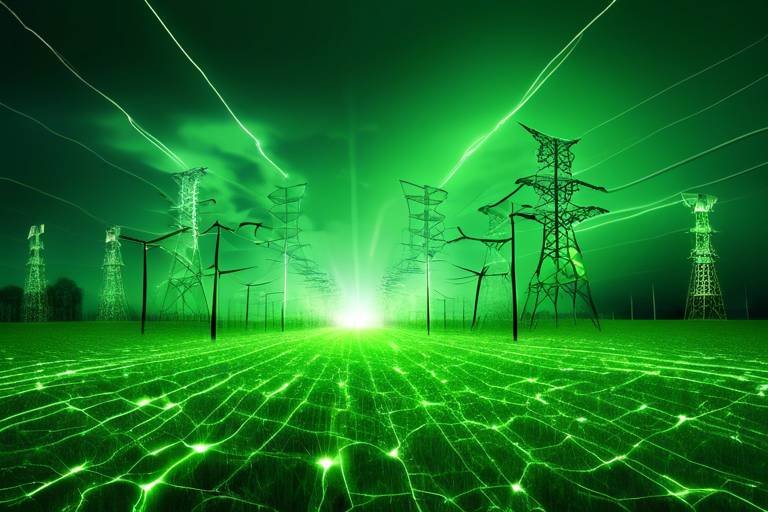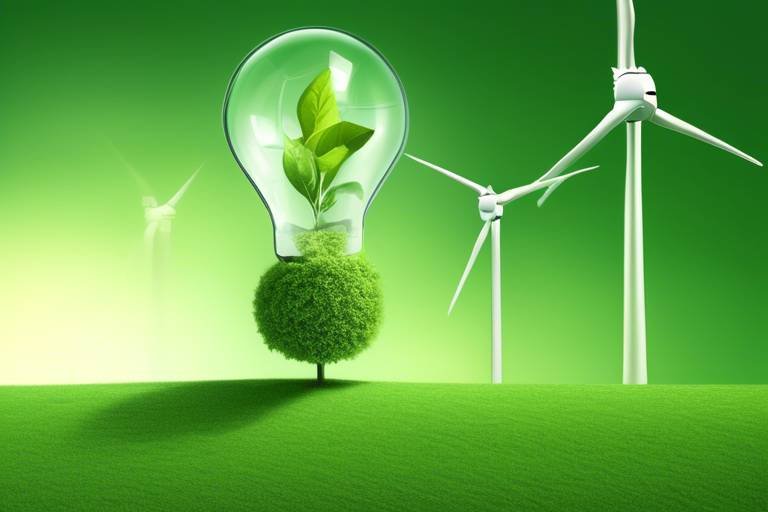Is Switching to Green Energy as Hard as It Sounds?
Transitioning to green energy can seem like a daunting task, but is it really as hard as it sounds? Many individuals and businesses are beginning to recognize the importance of making this shift, not just for the environment but also for their own financial well-being. The truth is, while there are challenges, the journey towards renewable energy is not insurmountable. It's similar to learning to ride a bike; at first, it seems complicated, but with a little guidance and practice, it becomes second nature.
One of the primary reasons people hesitate to switch to green energy is the misconception that it requires a complete overhaul of their current systems. However, the transition can be gradual and tailored to individual needs. For instance, you don’t have to go all-in with solar panels right away. You can start small by incorporating energy-efficient appliances or exploring community solar programs. This approach allows you to dip your toes in the water before making a bigger commitment.
Moreover, the benefits of switching to green energy are substantial and often outweigh the initial hurdles. Imagine reducing your energy bills while contributing to a healthier planet! It’s not just a dream; it's a reality for many who have taken the leap. The key is to stay informed and be proactive about seeking out resources and incentives that can facilitate this transition.
In the following sections, we will delve deeper into the various types of green energy, the barriers that may hinder your progress, and the practical steps you can take to embrace a more sustainable lifestyle. By the end of this article, you’ll have a clearer understanding of how to navigate the complexities of green energy and the confidence to embark on this rewarding journey.
- What is green energy? Green energy refers to energy derived from renewable sources that have a minimal environmental impact, such as solar, wind, and hydroelectric power.
- Is switching to green energy expensive? While the initial investment can be higher, various incentives and long-term savings on energy bills can make it more affordable over time.
- How can I start transitioning to green energy? You can start by assessing your current energy needs, researching available renewable energy options, and exploring local incentives.
- Are there government incentives for switching to green energy? Yes, many governments offer tax credits, rebates, and other financial incentives to encourage the adoption of renewable energy sources.

Understanding Green Energy
When we talk about green energy, we're diving into a world of renewable energy sources that are not only sustainable but also essential for the health of our planet. Think of it as the clean, fresh air compared to the smoggy clouds of traditional fossil fuels. Green energy encompasses a variety of sources, including solar, wind, and hydroelectric power, each with its unique characteristics and benefits.
Solar energy harnesses the power of the sun through solar panels, converting sunlight into electricity. It's like capturing the sun's rays in a bottle and using them to power your home. Wind energy, on the other hand, utilizes the natural movement of air to turn turbines, generating electricity. Imagine a giant pinwheel spinning in the breeze, transforming wind into power. Lastly, hydroelectric power relies on flowing water, such as rivers or dams, to produce energy. It's akin to using the force of a waterfall to generate electricity, creating a dynamic and efficient energy source.
One of the most significant advantages of green energy is its environmental benefit. Unlike fossil fuels, which release harmful greenhouse gases into the atmosphere, renewable sources produce little to no emissions. This means that by switching to green energy, we can significantly reduce our carbon footprint and combat climate change. Let’s break down some of the key benefits:
- Reduction in Greenhouse Gas Emissions: Transitioning to renewable sources helps decrease the amount of carbon dioxide and other pollutants released into the air.
- Preservation of Natural Ecosystems: Green energy minimizes the disruption of ecosystems, allowing wildlife to thrive.
- Resource Availability: Unlike fossil fuels, which are finite, renewable resources like sunlight and wind are abundant and will not run out.
In essence, understanding green energy is about recognizing the potential of these renewable sources to not only power our lives but also to protect our planet for future generations. As we navigate this transition, it’s crucial to grasp the various types of green energy available and their respective impacts, setting the stage for a more sustainable future.
As we explore the barriers and benefits of transitioning to green energy, it's essential to keep in mind that this journey is not just about technology—it's about making informed choices that contribute to a healthier planet. The more we understand green energy, the better equipped we will be to embrace this change.

Barriers to Transition
Transitioning to green energy is often viewed as a noble endeavor, but the reality is that many individuals and businesses encounter significant barriers along the way. These obstacles can be daunting, creating a sense of uncertainty and hesitation in making the switch. One of the primary challenges is financial constraints. The initial investment required for renewable energy systems, such as solar panels or wind turbines, can be substantial. Many people find themselves asking, "Can I really afford this?" This question is valid, especially for those on tight budgets or for small businesses trying to manage their operating costs.
Another critical barrier is the lack of information. Many potential adopters of green energy are simply unaware of the options available to them. This knowledge gap can lead to misinformation and misconceptions about renewable energy technologies. For instance, some might believe that solar energy is only viable in sunny climates, which is far from the truth. In reality, advancements in technology have made it possible to harness solar power even in less-than-ideal weather conditions. Therefore, educating oneself about the various renewable energy sources is essential for making informed decisions.
Moreover, infrastructure limitations can pose significant challenges. In some areas, the existing energy grid may not support the integration of renewable energy sources. This can lead to complications in connecting new systems to the grid, discouraging potential users from pursuing green energy options. Additionally, the availability of local resources, such as installers or maintenance services, can vary widely, further complicating the transition process.
To illustrate these barriers, consider the following table that summarizes key challenges faced by individuals and businesses when transitioning to green energy:
| Barrier | Description |
|---|---|
| Financial Constraints | High initial costs for installation and equipment can deter investment. |
| Lack of Information | Insufficient knowledge about renewable options leads to poor decision-making. |
| Infrastructure Limitations | Inadequate energy grid and local resources hinder the adoption of green technologies. |
Ultimately, while these barriers can seem overwhelming, they are not insurmountable. With the right information, support, and resources, individuals and businesses can navigate these challenges effectively. It's essential to remember that every small step toward adopting green energy contributes to a larger goal of sustainability and environmental responsibility. So, the next time you think about the difficulties of switching to green energy, consider the potential benefits that await on the other side of these hurdles.

Financial Challenges
When it comes to transitioning to green energy, one of the most significant hurdles that individuals and businesses face is the financial challenge. The initial investment required for renewable energy systems can be daunting. For many, the thought of spending thousands of dollars on solar panels or wind turbines feels overwhelming. However, it's essential to look beyond the upfront costs and consider the long-term benefits that these investments can bring.
For instance, while the installation of solar panels can range from $15,000 to $25,000 depending on the size and type of system, the savings on electricity bills can quickly add up. Many homeowners report saving anywhere from 20% to 50% on their energy costs after switching to solar. In addition to lower energy bills, there are also potential increases in property value, as homes with solar energy systems often sell for more.
Moreover, the financial landscape is not as bleak as it may seem at first glance. Various government incentives and programs have been established to encourage the adoption of green energy. These can significantly reduce the burden of initial costs. For example, tax credits can cover a substantial percentage of installation costs. In the United States, the federal solar tax credit allows homeowners to deduct 26% of the cost of installing a solar energy system from their federal taxes. This means that if you invest $20,000 in solar panels, you could save $5,200 in taxes!
Here’s a quick look at some of the financial incentives available:
| Incentive Type | Description | Potential Savings |
|---|---|---|
| Federal Tax Credit | Deduct a percentage of installation costs from federal taxes | Up to 26% |
| State Rebates | Direct cash back from state governments for installing renewable systems | Varies by state |
| Net Metering | Receive credits for excess energy produced and fed back to the grid | Variable savings |
In addition to government incentives, there are also financing options available to help ease the transition. Many companies offer solar loans or leasing options that allow customers to pay for their systems over time rather than all at once. This can make the switch to green energy more manageable and less intimidating.
While the initial costs of transitioning to green energy can be a significant barrier, it’s crucial to remember that these systems can lead to substantial long-term savings. By reducing reliance on traditional energy sources, households and businesses not only save money but also contribute to a more sustainable future. So, is the financial challenge of going green as hard as it sounds? It might be challenging, but with the right information and support, it’s entirely achievable!

Government Incentives
When it comes to transitioning to green energy, one of the most significant hurdles many individuals and businesses face is the financial aspect. Fortunately, various are designed to ease this burden and encourage the adoption of renewable energy sources. These incentives can take many forms, including tax credits, rebates, and grants, all aimed at making green energy more accessible and affordable.
For instance, tax credits allow homeowners and businesses to deduct a portion of the costs associated with installing renewable energy systems from their tax returns. This can significantly lower the upfront investment required. On the other hand, rebates provide immediate cash back for qualifying purchases, making it easier to manage initial expenses. Additionally, some local governments offer grants to help cover the costs of renewable energy projects, which can be especially beneficial for low-income households.
To give you a clearer picture, here's a table summarizing some common government incentives available for green energy adoption:
| Incentive Type | Description | Potential Benefits |
|---|---|---|
| Tax Credits | Allows deductions from federal or state taxes for renewable energy installations. | Reduces overall tax liability, making green energy systems more affordable. |
| Rebates | Direct cash back for the purchase and installation of renewable energy systems. | Provides immediate financial relief and reduces upfront costs. |
| Grants | Funds provided by local or state governments to support renewable energy projects. | Helps cover installation costs, especially for low-income households. |
Moreover, it's essential to stay informed about the specific incentives available in your area, as these can vary widely from one region to another. Many states have their own programs that complement federal initiatives, creating a layered approach to financial support for green energy. Websites like Energy.gov provide valuable resources and tools to help you navigate these options.
In conclusion, while the initial costs of switching to green energy can seem daunting, government incentives play a crucial role in alleviating these financial challenges. By taking advantage of these programs, you can make a significant step toward a sustainable future without breaking the bank.
- What types of renewable energy are eligible for government incentives? Most incentives apply to solar, wind, geothermal, and sometimes even biomass energy systems.
- How do I find out what incentives are available in my area? You can check local government websites, utility companies, or resources like Energy.gov for detailed information.
- Are there any income restrictions for receiving these incentives? Some programs may have income limits, especially for grants and rebates aimed at low-income households.

Long-term Savings
When it comes to the financial aspect of transitioning to green energy, many people often focus solely on the initial investment. However, what they may not realize is that can significantly outweigh those upfront costs. Think of it like planting a tree; while it may take time to grow, once it does, the shade and fruit it provides are well worth the wait. In this case, the tree is your green energy system, and the shade is the savings you'll enjoy over time.
For instance, homeowners who switch to solar panels can expect to see a dramatic reduction in their monthly electricity bills. According to recent studies, households that adopt solar energy can save anywhere from 20% to 50% on their energy costs. This means that over a span of 20 years, the savings can accumulate to tens of thousands of dollars. To illustrate this, let’s break it down in a simple table:
| Year | Estimated Monthly Savings | Total Savings |
|---|---|---|
| 1 | $100 | $1,200 |
| 5 | $100 | $6,000 |
| 10 | $100 | $12,000 |
| 20 | $100 | $24,000 |
In addition to reduced energy bills, many green energy solutions come with low maintenance costs. For example, solar panels typically require minimal upkeep, often just a periodic cleaning and inspection. This is in stark contrast to traditional energy sources, where maintenance costs can be unpredictable and often quite high. Over time, these savings can add up, creating a financial cushion for homeowners.
Moreover, the adoption of green energy systems can increase property values. Homes equipped with solar panels or other renewable energy sources are often more attractive to buyers, as they represent lower ongoing costs and a commitment to sustainability. In a market that increasingly values energy efficiency, this can translate to a significant return on investment when it's time to sell.
Lastly, it’s worth mentioning the potential for government incentives, which can further enhance long-term savings. Many regions offer tax credits, rebates, and grants that can offset the initial costs of installation. By taking advantage of these programs, individuals and businesses can make the transition to green energy even more financially feasible. So, not only are you saving money in the long run, but you're also contributing to a more sustainable future.
In conclusion, while the switch to green energy may require an initial financial commitment, the long-term savings are undeniable. By reducing energy bills, minimizing maintenance costs, increasing property values, and leveraging available incentives, you can ensure that your investment pays off in more ways than one.
- What are the initial costs associated with switching to green energy? The initial costs can vary depending on the type of renewable energy system you choose, but many programs offer incentives to help alleviate these costs.
- How long does it take to see savings from green energy? Many homeowners start seeing savings on their energy bills within the first year of installation, with substantial savings accumulating over time.
- Are there any maintenance costs associated with green energy systems? Generally, green energy systems like solar panels require minimal maintenance, which can result in lower ongoing costs compared to traditional energy sources.
- Can green energy increase my property value? Yes, homes with renewable energy systems often have higher property values and are more attractive to potential buyers.

Information Gaps
When it comes to transitioning to green energy, one of the most significant hurdles many individuals and businesses face is a simple yet profound issue: . It's not that people are unwilling to make the switch; rather, they often lack the necessary knowledge to do so effectively. Imagine standing in front of a vast ocean of renewable energy options, but only having a tiny boat to navigate through it. This is how many feel when confronted with the complexities of green energy.
Many homeowners and business owners are unsure where to start or what options are available to them. For instance, they might be unaware of the differences between solar panels, wind turbines, and geothermal systems, or they may not understand how these technologies can be integrated into their existing infrastructure. This lack of understanding can lead to hesitation, causing potential adopters to miss out on the benefits that green energy can provide.
Moreover, the rapid pace of technological advancements in the renewable energy sector can create further confusion. New products and solutions emerge almost daily, making it challenging to keep up with the latest developments. Individuals may find themselves overwhelmed by the multitude of choices, which can lead to indecision and ultimately, inaction. It’s akin to trying to choose a dish from an extensive menu at a restaurant without having any prior knowledge of the ingredients or flavors.
To bridge these information gaps, education plays a crucial role. It's essential to create accessible resources that inform the public about the various green energy options available, their benefits, and how to implement them. This could include workshops, webinars, and online courses that demystify renewable energy technologies and provide step-by-step guidance on transitioning. Additionally, community outreach programs can foster a dialogue between energy providers and consumers, helping to dispel myths and clarify misconceptions about green energy.
Furthermore, the importance of utilizing credible sources cannot be overstated. Engaging with local energy cooperatives, government agencies, and reputable organizations dedicated to renewable energy can provide valuable insights and tailored advice. For example, local energy cooperatives often have resources available to help residents understand their energy consumption and identify suitable renewable solutions.
In conclusion, addressing the information gaps in the green energy sector is vital for fostering a more sustainable future. By empowering individuals and businesses with the knowledge they need, we can encourage more people to embrace renewable energy sources, ultimately leading to a cleaner, greener planet for future generations.
- What are the most common types of green energy? The most common types of green energy include solar, wind, hydroelectric, and geothermal energy.
- How can I determine which green energy source is best for me? Assess your energy needs, consider your location, and research the available options in your area to determine the best fit.
- Are there financial incentives for switching to green energy? Yes, many governments offer tax credits, rebates, and other incentives to encourage the adoption of renewable energy sources.
- How long does it take to see savings from green energy? While the initial investment may be high, many people start seeing savings within a few years due to reduced energy bills and maintenance costs.

Benefits of Green Energy
Transitioning to green energy is not just a trend—it's a necessity for a sustainable future. As we dive into the myriad benefits of adopting renewable energy sources, it becomes clear that the advantages extend far beyond mere environmental factors. One of the most significant benefits is the positive impact on our planet. By switching to green energy, we can drastically reduce our carbon footprint and contribute to a healthier ecosystem. Imagine a world where clean air and pristine nature are the norms rather than the exceptions. That's the power of green energy!
Furthermore, green energy promotes energy independence. Many countries rely heavily on imported fossil fuels, which can lead to economic instability and vulnerability to global market fluctuations. By harnessing local renewable resources—like solar, wind, and hydro—communities can generate their own energy. This not only fosters energy security but also stimulates local economies by creating jobs in the renewable energy sector. It's a win-win situation where both the environment and the economy benefit.
Let’s not forget about the financial benefits. While the initial investment in green technology may seem daunting, the long-term savings can be substantial. Many households and businesses report significant reductions in their energy bills after switching to renewable sources. For instance, according to recent studies, homeowners who install solar panels can save thousands over the lifespan of the system. This financial relief can be a game-changer, allowing individuals to allocate their resources to other important areas of their lives.
In addition to the direct financial savings, there are also numerous government incentives available to ease the transition. Many governments offer tax credits, rebates, and grants to encourage the adoption of renewable energy technologies. These programs are designed to make green energy more accessible and affordable for everyone. For instance, a recent table illustrates some of the common incentives available:
| Incentive Type | Description | Potential Savings |
|---|---|---|
| Tax Credits | Reductions in income tax based on renewable energy investments | Up to 30% of installation costs |
| Rebates | Direct cash incentives for installing renewable energy systems | Varies by state and program |
| Grants | Funding provided by government agencies for renewable energy projects | Up to $10,000 or more depending on the project |
In essence, the benefits of green energy are multifaceted and far-reaching. They encompass environmental protection, economic stability, and financial savings, all while paving the way for a more sustainable future. So, why not take the plunge? The transition to renewable energy is not just a personal choice; it’s a collective step towards a healthier planet for generations to come.
- What are the main types of green energy? Green energy primarily includes solar, wind, hydroelectric, and geothermal energy.
- How can I start using green energy at home? You can start by assessing your energy needs, researching local options, and considering solar panel installation or energy-efficient appliances.
- Are there financial incentives for switching to green energy? Yes, many governments offer tax credits, rebates, and grants to help offset the costs of renewable energy systems.
- What are the long-term savings associated with green energy? Users often experience lower energy bills and reduced maintenance costs over time, leading to significant savings.

Environmental Impact
The environmental impact of transitioning to green energy is profound and far-reaching. When we talk about green energy, we're referring to sources that are not only renewable but also significantly less harmful to our planet compared to traditional fossil fuels. Imagine a world where the air is cleaner, the water is purer, and ecosystems thrive instead of being choked by pollution. By switching to renewable sources like solar, wind, and hydroelectric power, we can drastically reduce greenhouse gas emissions, which are the primary culprits behind climate change.
For instance, did you know that the burning of fossil fuels contributes to around 70% of global CO2 emissions? By opting for green energy, we can cut down these emissions and take a significant step toward mitigating climate change. The benefits of this transition extend beyond just lower emissions; they also encompass the preservation of biodiversity and the protection of natural habitats. Renewable energy sources require less land and water than traditional energy production methods, which means we can conserve our precious ecosystems.
Moreover, the shift to green energy can lead to a decrease in air and water pollution. Traditional energy production processes release harmful pollutants that can cause respiratory problems and other health issues in humans and wildlife alike. By reducing reliance on these harmful energy sources, we can improve public health and create a cleaner environment for future generations. Consider the following environmental benefits of switching to green energy:
- Reduction of Greenhouse Gases: Transitioning to renewable energy sources can significantly lower carbon emissions.
- Conservation of Natural Resources: Green energy utilizes resources that are naturally replenished, such as sunlight and wind.
- Enhancement of Biodiversity: Less pollution means healthier ecosystems, which can support a wider variety of plant and animal life.
- Improved Air Quality: With fewer pollutants being released into the atmosphere, the air we breathe becomes cleaner and safer.
In addition to these environmental benefits, investing in green energy can also stimulate economic growth. The renewable energy sector is one of the fastest-growing industries, creating jobs in manufacturing, installation, and maintenance. This not only helps the economy but also fosters a sense of community as we come together to work towards a sustainable future. In summary, the environmental impact of switching to green energy is overwhelmingly positive, offering a path toward a healthier planet and a more sustainable way of life.
Q: What are the main types of green energy?
A: The main types of green energy include solar, wind, hydroelectric, geothermal, and biomass energy. Each of these sources harnesses natural processes to generate power without depleting resources.
Q: How does green energy help combat climate change?
A: Green energy helps combat climate change by reducing greenhouse gas emissions that contribute to global warming. By transitioning away from fossil fuels, we can lower our carbon footprint and mitigate the effects of climate change.
Q: Are there financial incentives for switching to green energy?
A: Yes, many governments offer financial incentives such as tax credits, rebates, and grants to encourage the adoption of green energy. These incentives can help offset the initial costs of installing renewable energy systems.
Q: Can I transition to green energy in my home?
A: Absolutely! Homeowners can install solar panels, wind turbines, or even participate in community solar projects to start using green energy. It's a great way to reduce energy bills and contribute to a sustainable future.

Energy Independence
Imagine waking up in a world where your energy source is not dependent on distant countries, fluctuating prices, or geopolitical tensions. This is the promise of , a goal that can be achieved through the adoption of green energy sources. By utilizing local renewable resources, communities can significantly reduce their reliance on imported fuels, creating a more stable and sustainable energy landscape.
When we talk about energy independence, we're not just referring to the ability to produce our own energy; it's about fostering a sense of security and resilience. For instance, consider how local solar farms or wind turbines can empower a community. Instead of being at the mercy of oil prices that can skyrocket overnight, residents can harness the power of the sun and wind, which are abundant and free. This shift not only stabilizes costs but also ensures that energy remains accessible even during crises.
Furthermore, energy independence has a ripple effect on the economy. By investing in local renewable energy projects, jobs are created in installation, maintenance, and innovation sectors. This not only boosts the local economy but also keeps money circulating within the community rather than sending it off to foreign oil suppliers. It’s a win-win situation that fosters both economic growth and environmental sustainability.
As we explore the concept of energy independence, it's essential to recognize the role of government policies and community initiatives in facilitating this transition. Many regions are now implementing programs that encourage the development of renewable energy infrastructure. These initiatives can include:
- Subsidies for renewable energy projects
- Grants for research and development in clean energy technologies
- Community-based energy programs that promote local participation
In conclusion, achieving energy independence through green energy is not merely a dream; it is a tangible goal that can be reached with collective effort and commitment. By embracing renewable energy sources, we can create a future where energy is abundant, affordable, and sustainable, ultimately leading to healthier communities and a healthier planet.
Q: What is energy independence?
A: Energy independence refers to the ability of a country or community to produce its own energy, reducing reliance on imported fuels and enhancing energy security.
Q: How does green energy contribute to energy independence?
A: Green energy sources such as solar, wind, and hydroelectric power allow communities to harness local resources, thereby decreasing dependence on foreign energy supplies.
Q: What are some examples of renewable energy sources?
A: Common renewable energy sources include solar power, wind power, hydroelectric power, geothermal energy, and biomass.
Q: Can transitioning to green energy save me money?
A: Yes! While the initial investment might be higher, green energy can lead to significant long-term savings through reduced energy bills and lower maintenance costs.
Q: What government incentives are available for adopting green energy?
A: Various incentives exist, including tax credits, rebates, and grants aimed at reducing the financial burden of transitioning to renewable energy.

Steps to Transition
Transitioning to green energy may sound daunting, but it can be a straightforward journey if you take it one step at a time. The first crucial step is to assess your energy needs. Understanding your current energy consumption is vital. You can start by reviewing your utility bills from the past year. This will give you a clear picture of how much energy you use and when you use it the most. Are there peak times when your consumption spikes? Identifying these patterns can help you make informed decisions about energy efficiency improvements.
Once you have a grasp of your energy usage, the next step is to choose the right renewable energy source. This decision will depend on various factors, including your location, budget, and energy requirements. For instance, if you live in a sunny area, solar panels might be the perfect fit for you. On the other hand, if you reside in a windy region, wind turbines could harness that natural resource effectively. It's essential to evaluate the pros and cons of each option:
| Energy Source | Pros | Cons |
|---|---|---|
| Solar Energy | Abundant in sunny areas, low maintenance costs | High initial installation costs, dependent on sunlight |
| Wind Energy | Cost-effective in windy regions, low emissions | Noise concerns, visual impact on landscapes |
| Hydroelectric Energy | Reliable and efficient, can provide large amounts of energy | Environmental impact on aquatic ecosystems, high initial costs |
After selecting the right source, consider investing in energy efficiency upgrades for your home or business. Simple changes like improving insulation, installing energy-efficient appliances, and using smart thermostats can significantly reduce your overall energy consumption. These upgrades not only make your transition smoother but also help you save money in the long run.
Another essential aspect of transitioning is to stay informed and educated. The world of green energy is constantly evolving, with new technologies and incentives emerging regularly. Follow industry news, attend workshops, or join local sustainability groups to stay updated. You can also consult with energy experts who can provide tailored advice and solutions for your specific situation.
Finally, don't hesitate to engage with your community. Share your experiences and learn from others who have made the switch to green energy. Whether through social media, community forums, or local events, connecting with like-minded individuals can offer you valuable insights and encouragement. Remember, transitioning to green energy is not just about individual efforts; it's a collective movement towards a sustainable future.
- What is green energy? Green energy refers to renewable energy sources such as solar, wind, and hydroelectric power that have minimal environmental impact.
- How much does it cost to switch to green energy? The initial costs can vary widely depending on the energy source and installation specifics, but there are often incentives available to help reduce these costs.
- Can I still use traditional energy sources? Yes, many people use a combination of renewable and traditional energy sources, known as a hybrid system.
- What are the long-term benefits of green energy? Long-term benefits include reduced energy bills, lower maintenance costs, and a positive impact on the environment.

Assessing Energy Needs
When it comes to transitioning to green energy, the very first step is all about understanding your current energy consumption. This is crucial because, just like a doctor diagnosing a patient, you need to know what you're working with before you can prescribe the right solution. Assessing your energy needs involves taking a close look at how much energy you use, when you use it, and where you can potentially cut back. It’s like peeking under the hood of your car before deciding to upgrade the engine; you want to know what parts are running smoothly and what needs a little TLC.
Start by gathering your energy bills from the past year. Look for patterns in your usage: are there certain months when your consumption spikes? This can give you insights into seasonal energy demands, such as heating in winter or cooling in summer. You can track your energy consumption in a simple table:
| Month | Energy Usage (kWh) | Notes |
|---|---|---|
| January | 800 | High heating costs |
| February | 750 | Still cold, but less heating |
| March | 600 | Spring starts, less heating |
| April | 500 | Transition to warmer weather |
| May | 450 | Low energy usage |
| June | 700 | Increased cooling usage |
| July | 900 | Peak cooling costs |
| August | 850 | Still high cooling |
| September | 600 | Cooling decreases |
| October | 500 | Heating starts |
| November | 700 | Higher heating costs |
| December | 850 | Coldest month |
This table is a great tool to visualize your energy consumption and identify trends. Once you have a clear picture of your energy usage, you can begin to pinpoint areas where you might improve efficiency. For instance, if you notice that your energy consumption is particularly high during certain months, you might want to consider investing in better insulation or energy-efficient appliances. It’s like finding the weak spots in your home and patching them up to save energy and costs.
Next, think about your lifestyle and habits. Are there appliances that run constantly, or do you have a home office that requires significant energy for computers and equipment? Understanding your personal and household energy habits can help you decide which green energy solutions will be most beneficial. For example, if you work from home, investing in solar panels might be a no-brainer, as they can offset the costs of running your home office.
Finally, don’t forget to consider future needs. Are you planning on expanding your family or adding more technology to your home? Anticipating these changes can help you choose a green energy solution that not only meets your current needs but also accommodates future growth. Remember, transitioning to green energy is not just about what you need today; it’s about creating a sustainable future for tomorrow!
- What is green energy? Green energy is derived from renewable sources such as solar, wind, and hydroelectric power, which have minimal impact on the environment.
- How can I assess my energy needs? Start by reviewing your energy bills, tracking usage patterns, and considering future changes in your household or business.
- Are there incentives for switching to green energy? Yes, many governments offer tax credits, rebates, and other incentives to encourage the adoption of green energy solutions.
- What are the long-term benefits of switching to green energy? Besides reducing your carbon footprint, green energy can lead to significant savings on energy bills and increased energy independence.

Choosing the Right Source
When it comes to transitioning to green energy, one of the most critical decisions you'll face is choosing the right renewable energy source for your needs. It's a bit like picking the perfect ingredient for a recipe; you want something that not only fits your taste but also complements the rest of your dish. The right choice can lead to significant savings and efficiency, while the wrong one might leave you feeling frustrated and underwhelmed.
First off, it's essential to assess your location and the natural resources available to you. For instance, if you live in a sunny area, solar energy might be your best bet. On the other hand, if you reside near a coastline or in a windy region, wind energy could be a fantastic option. Understanding your local climate and geography can help you make an informed decision.
Let's break it down a bit further:
- Solar Energy: Harnessing the power of the sun, solar panels can be installed on rooftops or in large fields. They are generally easy to maintain and can significantly reduce your electricity bills.
- Wind Energy: If you have ample space and consistent winds, wind turbines can be a great investment. They require more space than solar panels but can produce substantial energy, especially in rural areas.
- Hydroelectric Power: This source is incredibly efficient but requires access to flowing water. Small-scale hydro setups can be an option for those near rivers or streams.
- Geothermal Energy: If you live in a region with geothermal activity, tapping into this energy can provide consistent heating and cooling solutions.
Each of these energy sources comes with its own set of advantages and challenges. For example, while solar energy systems can be installed quickly, they can also be limited by weather conditions and the initial investment. Wind energy systems, on the other hand, might require more land and can be subject to local regulations regarding turbine placement. Therefore, it's crucial to consider not just the potential energy output but also the local regulations, installation costs, and maintenance requirements.
Furthermore, consider your energy consumption patterns. Are you a household that uses a lot of electricity during the day? If so, solar energy might be the most effective option for you. Alternatively, if your energy needs are more consistent throughout the day and night, a combination of solar and wind energy might provide a more balanced approach.
Finally, don’t underestimate the importance of consulting with professionals in the field. They can provide valuable insights into the feasibility and efficiency of different energy sources based on your specific circumstances. Think of them as your personal trainers in the gym of energy solutions—they will help you find the best path to achieving your sustainability goals.
1. What factors should I consider when choosing a renewable energy source?
Consider your location, local climate, energy consumption patterns, and the initial investment required for installation.
2. Can I combine different energy sources?
Absolutely! Many households and businesses benefit from a hybrid approach, utilizing multiple sources to enhance efficiency and reliability.
3. How do I find a reliable installer for renewable energy systems?
Research local companies, read reviews, and ask for recommendations from friends or community groups to find reputable installers.
4. Are there any financial incentives for switching to renewable energy?
Yes, many governments offer tax credits, rebates, and grants to encourage the adoption of green energy solutions.
Frequently Asked Questions
- What is green energy?
Green energy refers to energy derived from renewable sources such as solar, wind, and hydroelectric power. Unlike traditional fossil fuels, green energy is sustainable and has a significantly lower environmental impact, helping to reduce greenhouse gas emissions and combat climate change.
- Why should I switch to green energy?
Switching to green energy can lead to numerous benefits, including lower energy bills, reduced carbon footprint, and increased energy independence. It also contributes to a healthier planet by preserving natural ecosystems and reducing pollution.
- What are the main barriers to switching to green energy?
Common barriers include financial constraints, lack of information, and infrastructure limitations. Many people are unsure about the costs associated with green energy systems and may not be aware of available incentives that can help ease the financial burden.
- Are there financial incentives for switching to green energy?
Yes, various government programs offer incentives such as tax credits, rebates, and grants to encourage the adoption of green energy. These financial aids can significantly reduce the initial investment required to install renewable energy systems.
- How can I assess my energy needs?
To assess your energy needs, start by reviewing your current energy consumption. Look at your utility bills, identify peak usage times, and determine areas where you can improve efficiency. This will help you make informed decisions about the type of renewable energy source that best fits your needs.
- What renewable energy sources should I consider?
Choosing the right renewable energy source depends on your location and personal needs. Common options include solar panels, wind turbines, and geothermal systems. Research local resources and consult with experts to find the best solution for your situation.
- Can green energy really save me money in the long run?
Absolutely! While the initial costs of installing green energy systems can be high, they often lead to significant long-term savings through reduced energy bills and lower maintenance costs. Over time, these savings can offset the upfront investment.
- How does green energy contribute to energy independence?
Utilizing local renewable resources reduces reliance on imported fossil fuels, which enhances energy security for communities and nations. By generating energy locally, you can protect yourself from price fluctuations and supply disruptions associated with traditional energy sources.

